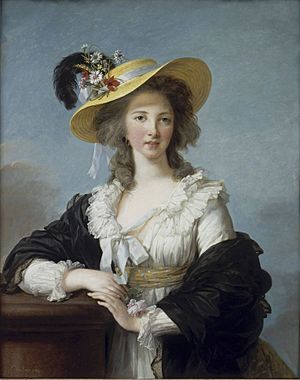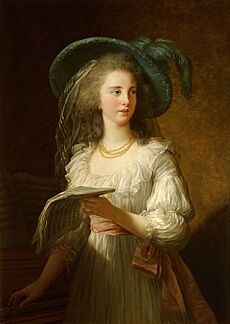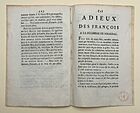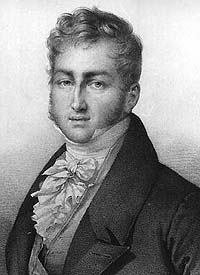Yolande de Polastron facts for kids
Quick facts for kids
Yolande de Polastron
|
|
|---|---|
| Duchesse de Polignac | |

Portrait by Elisabeth Vigée-Lebrun, 1782.
(Styled after Self-portrait in a Straw Hat) |
|
| Born | 8 September 1749 Paris, France |
| Died | 9 December 1793 (aged 44) Vienna, Austria, Holy Roman Empire |
| Spouse(s) |
Jules de Polignac
(m. 1767) |
| Issue | Aglaé de Polignac Armand de Polignac Jules de Polignac Camille de Polignac |
| Father | Jean François Gabriel de Polastron |
| Mother | Jeanne Charlotte Hérault |
Yolande Martine Gabrielle de Polastron (born September 8, 1749 – died December 9, 1793) was a close friend of Marie Antoinette. Marie Antoinette was the Queen of France. Gabrielle met the Queen in 1775 at the Palace of Versailles. Many people thought Gabrielle was very beautiful. However, her expensive lifestyle and exclusive friendships made her many enemies.
Contents
Early Life and Family
Yolande Martine Gabrielle de Polastron was born in Paris, France. This was during the time of King Louis XV. Her parents were Jean François Gabriel and Jeanne Charlotte Hérault. She was usually called Gabrielle. Her family was old and noble, but they had many debts. Their life was not very fancy.
When Gabrielle was a baby, her family moved to a place called Château of Noueilles. Her mother died when Gabrielle was only three years old. An aunt took care of her and sent her to a convent for her education.
At 16, Gabrielle was set to marry Jules François Armand, comte de Polignac. They married on July 7, 1767. Jules's family was also noble but not very rich. Jules worked in the army and earned 4,000 livres a year. This was a type of money used back then. Gabrielle and Jules had four children. One of their sons, Jules, prince de Polignac, later became a very important leader in France.
How She Looked
Many paintings show Gabrielle as a very pretty woman. One historian said she looked "like some harvested and luscious fruit." She had dark brown hair and very pale skin. Her eyes were a rare lilac or violet color.
People at the time said she looked "utterly natural." She had a lot of dark hair, big eyes, and a neat nose. Her teeth were pretty and pearly. Many compared her beauty to a Madonna painting by Raphael.
Life at Versailles

Gabrielle's sister-in-law, Diane de Polignac, invited her to the royal court. This was at the Palace of Versailles. Gabrielle and her husband came in 1775. She was formally introduced to Queen Marie Antoinette. The Queen was immediately impressed by Gabrielle. She asked Gabrielle to live at Versailles permanently.
Living at Versailles was very expensive. Gabrielle told the Queen her family could not afford it. The Queen wanted her friend close by. So, she agreed to pay off Gabrielle's family debts. She also found a job for Gabrielle's husband.
Once Gabrielle lived at the palace, she became good friends with the King's youngest brother, the comte d'Artois. King Louis XVI also liked Gabrielle. He was happy she had a calming effect on his wife. However, other people at court did not like Gabrielle. The Queen's confessor and the Austrian ambassador were among them. The ambassador wrote that it was very unusual for a family to gain so much favor so quickly.
Gabrielle was charming and beautiful. She became the leader of the Queen's inner circle of friends. Few people could join this group without Gabrielle's approval. Her friends thought she was elegant, sophisticated, and fun.
The Queen was very generous to the Polignac family. They became very wealthy and lived a lavish life. This made many other noble families angry. They did not like how much power the Polignacs had at court. The Queen's favoritism towards the Polignac family made her unpopular. This was especially true with people in Paris and some liberal nobles. In 1780, Gabrielle's husband became the duc de Polignac. This made Gabrielle a duchesse. This new title caused even more irritation among the courtiers.
Some historians say that Gabrielle did deserve some of the criticism. They describe her as sometimes cold and focused on herself. They also say she hid a love for gossip and plotting behind her sweet voice and perfect manners.
Royal Governess

In 1782, the person in charge of the royal children, Victoire de Rohan, had to leave her job. This was because her husband went bankrupt. The Queen chose Gabrielle to take her place. This decision caused a lot of anger at court. Many felt Gabrielle's social rank was not high enough for such an important role.
Because of her new job, Gabrielle received a large 13-room apartment at the palace. This was much bigger than the usual four or five rooms given to royal governesses. She even got her own small house. This house was in Marie Antoinette's favorite country retreat, the Hameau de la Reine. This was a special village built on the grounds of the Petit Trianon at Versailles.
Her Children
- Aglaé Louise Françoise Gabrielle de Polignac (born May 7, 1768, Paris; died March 30, 1803, Edinburgh). Her family called her Guichette. She married Antoine duc de Gramont et Guiche in 1780.
- Armand Jules Marie Héracle de Polignac, duc de Polignac (born January 11, 1771, Paris; died March 1, 1847, Paris). He became the second duc de Polignac.
- Jules, prince de Polignac (born November 10, 1780, Paris; died March 30, 1847, Saint-Germain-en-Laye). He became the third duc de Polignac. He was the French Prime Minister from 1829 to 1830. This was under Gabrielle's friend, Charles X.
- Camille Henri Melchior de Polignac, comte de Polignac (born December 27, 1781, Versailles; died February 2, 1855, Fontainebleau).
Later Life and Exile
After 1785, Gabrielle's influence over Marie Antoinette lessened for a while. The Queen was becoming unhappy with how ambitious her friends were. Marie Antoinette told another lady-in-waiting that she was "suffering acute dissatisfaction" over the Polignacs. She felt that when a ruler gives too much power to favorites, those favorites can become too demanding. Gabrielle felt the Queen's displeasure. She decided to visit friends in England. One of her closest friends there was Georgiana Cavendish, Duchess of Devonshire. In England, Gabrielle was nicknamed "Little Po" because she was often delicate.
The French Revolution
In the months before the French Revolution began in July 1789, the Queen and Gabrielle became close again. Gabrielle and her friends supported the King and Queen very strongly. As the summer went on, Gabrielle became more involved in royal plans. She often worked with her friend, the comte d'Artois.
A diplomat named the marquis de Bombelles said Gabrielle worked hard to push for strong actions against the growing revolution. With other royal supporters, Gabrielle convinced Marie Antoinette to act against the King's finance minister, Jacques Necker. However, the King did not have enough military support to stop the unrest. Necker's dismissal led to serious violence in Paris. This ended with the attack on the Bastille fortress.
After the storming of the Bastille on July 14, 1789, the entire Polignac family had to leave France. King Louis XVI ordered them to go. Gabrielle went with her family to Switzerland. She stayed in touch with the Queen through letters. After Gabrielle left, another lady, the Marquise de Tourzel, took care of the royal children.
Life in Exile
After leaving France, Gabrielle and her family moved around a lot. They traveled through Switzerland, Italy, and then to Vienna, Austria, in 1791. She kept writing to Marie Antoinette, which helped track where she lived. She was also seen at a gathering of French nobles who had left France, in Koblenz. However, this gathering broke up after a battle in 1792. Gabrielle then returned to Austria.
Gabrielle became very ill while in Switzerland. She had not been well for several years. She died in Austria in December 1793. This was shortly after she heard that Marie Antoinette had been executed.
Her Descendants
Gabrielle was the mother of Jules, prince de Polignac. He became Prime Minister for Charles X in 1829. She was also the mother of Aglaé de Polignac, who died in a fire in 1803. Two of her grandsons were Camille Armand Jules Marie and Prince Edmond de Polignac. Her great-great-grandson, Count Pierre de Polignac, was the father of Rainier III, Prince of Monaco. Her family members can also be found in France and Russia today.
In Movies and TV
Gabrielle de Polastron's story has been told in many movies and TV shows:
- Antoinette (USA, 1938) played by Ruth Hussey
- Marie Antoinette - Reine de France (1956) played by Marina Berti
- Marie-Antoinette (1975) played by Corinne Le Poulain
- Les Années Lumière (1988) played by Claudia Cardinale
- L’été de la Révolution (1989) played by Yolande Folliot
- Marie-Antoinette, Reine d'un seul amour (1989) played by Isabelle Gélinas
- L'Autrichienne (1989)
- Marie-Antoinette (2006) played by Rose Byrne
- Marie-Antoinette, la Véritable Histoire (2006) played by Marie-Ève Beaulieu
- Les Adieux à la Reine (2012) played by Virginie Ledoyen
- Marie Antoinette (2022) played by Liah O’Prey
See also
 In Spanish: Yolande de Polastron para niños
In Spanish: Yolande de Polastron para niños



